Asylum applications - monthly statistics
Data extracted on 14 June 2024
Planned article update: 19 July 2024
Highlights
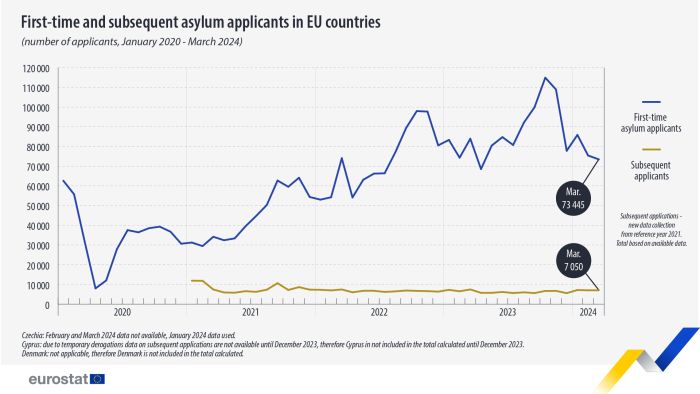
Source: Eurostat (migr_asyappctzm)
This article describes recent developments in relation to the number of asylum applicants in the European Union (EU). Asylum is a form of international protection given by a state on its territory. It is granted to a person who is unable to seek protection in their country of citizenship and/or residence, in particular for fear of being persecuted for reasons of race, religion, nationality, membership of a particular social group, or political opinion.
The legal basis for the asylum data collection is Regulation (EC) No 862/2007. An amendment to this regulation adopted in June 2020 introduced additional new statistics. It increased the frequency, timeliness and the level of detail of asylum statistics from reference year 2021, including more frequent and detailed information on unaccompanied minors who represent a particularly vulnerable group seeking protection. In addition, Eurostat started to collect data on subsequent asylum applicants, on asylum applications under accelerated procedure, on applicants benefiting from material reception conditions and on types of withdrawals of asylum applications. The datasets with the new statistics are continuously published in the Eurostat database and some of these new data are included in this article.
Full article
Main trends in the number of asylum applicants
In March 2024, there were 73 445 first-time asylum applicants [1] (non-EU citizens) applying for international protection in reporting EU countries (Figure 1), a decrease of 3% compared with February 2024 (75 405). Compared with March 2023, it represented a 12% decrease (83 915).
There were also 7 050 subsequent applicants, a less than 1% increase compared with February 2024 (7 015). Compared with March 2023, it represented a 6% decrease (7 475).
Men aged 18-34 years accounted for 39% of the total number of first-time applicants (Figure 2). Regarding children aged less than 14 years, 52 % were boys and 48% were girls. Most children aged 14-17 years were boys (72%) and 28% were girls.

Source: Eurostat (migr_asyappctzm)
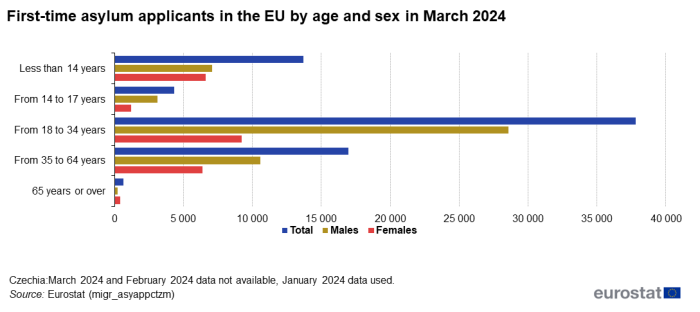
Source: Eurostat (migr_asyappctzm)
In March 2024, the EU total of first-time asylum applicants was 16.4 per hundred thousand people (Figure 3). Compared with the population of each EU country (on 1 January 2023), the highest rates of first-time applicants were recorded in Cyprus (124.0) and Greece (36.0).

Source: Eurostat (migr_asyappctzm) and (demo_gind)
Where do asylum applicants come from?
In March 2024, Syrians were the largest group of people seeking asylum (10 470 first-time applicants). They were followed by Afghans (5 735) and Venezuelans (5 440) (Figure 4).

Source: Eurostat (migr_asyappctzm)
Where do asylum applicants make their application?
In March 2024, Germany (16 430), Italy (15 115), Spain (13 255) and France (10 540) received 75% of all first-time asylum applicants in the EU (Map 1). The number of applicants in March 2024 decreased compared to February 2024, representing a total decrease of 3% in the EU (Figure 5).
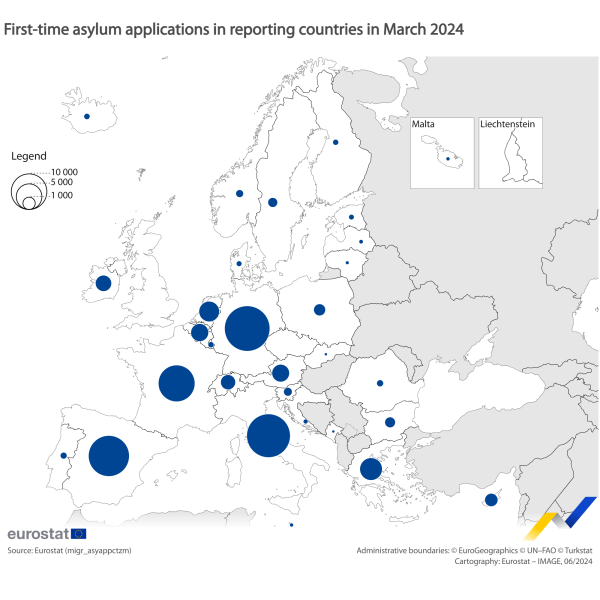
Source: Eurostat (migr_asyappctzm)
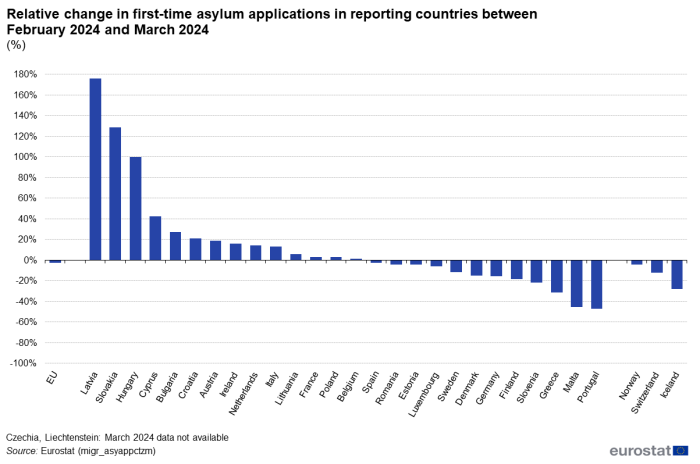
Source: Eurostat (migr_asyappctzm)
Where do unaccompanied minors come from?
An unaccompanied minor is a person aged less than 18 years who arrives on the territory of an EU country not accompanied by an adult responsible for the minor, or a minor who is left unaccompanied after having entered the territory of a country . In March 2024, 2 340 unaccompanied minors applied for asylum for the first time in the EU, with most coming from Syria (785) and Afghanistan (325) (Figure 6).

Source: Eurostat (migr_asyumactm)
Where do unaccompanied minors go to make their application?
The EU countries that received the highest numbers of asylum applications from unaccompanied minors were Germany (920), ahead of the Netherlands (455) (Figure 7).

Source: Eurostat (migr_asyumactm)
Applications under the accelerated procedure
In 2021, Eurostat started collecting new data on asylum applications under an accelerated procedure [2]. Article 31(8) of Directive 2013/32/EU identifies ten grounds where the accelerated procedure may be applied, and thus where an EU country may reject a claim as manifestly unfounded. This concerns, for instance, cases where the applicant has only raised issues not relevant to refugee or subsidiary protection status, or if the applicant comes from a "safe country of origin" or where the applicant refuses to be fingerprinted.
Figure 8 presents the number of applicants who had their applications processed under the accelerated procedure over the last twelve months. In March 2024, France (4 570) registered the highest number of applications, ahead of Italy (2 000) and Greece (1 040).

Source: Eurostat (migr_asyaccm)
Pending applications
Pending applications for international protection are those that have been made at any time and are still under consideration by the relevant national authorities at the end of the reference period. In other words, they refer to the number of applications for which decisions are still pending. Figure 9 shows the number of applications for asylum protection in the EU countries under consideration by the national authorities (so called 'pending application') over the last twelve months. Map 2 shows the number of pending applications in reporting countries. In March 2024, Germany had the highest numbers of pending applications, ahead of Spain, Italy and France. Details for each reporting country are available in the interactive map of the data browser.
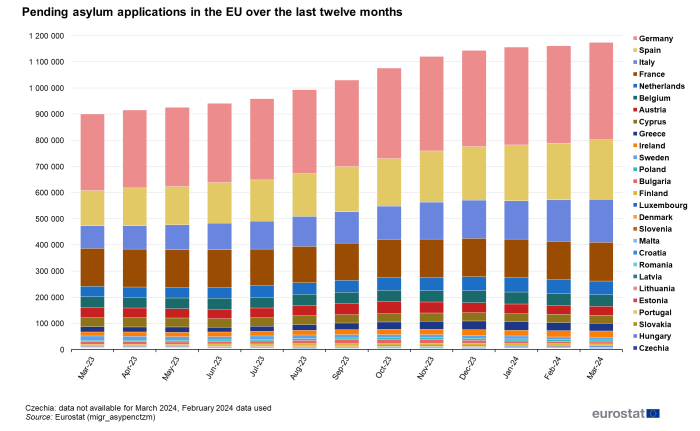
Source: Eurostat (migr_asypenctzm)
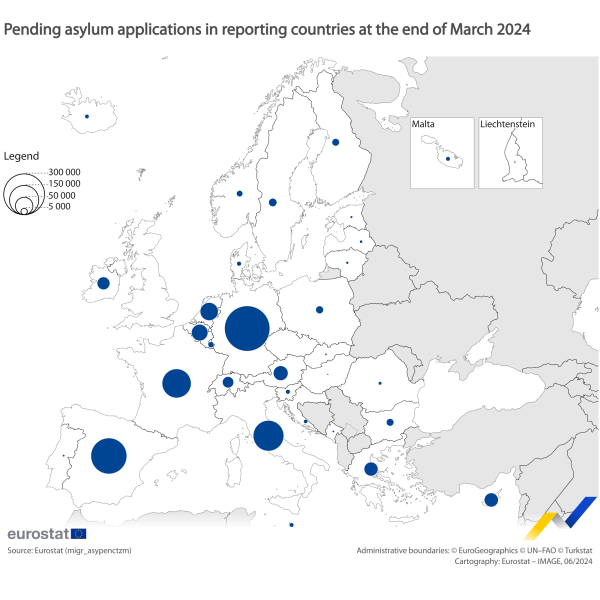
Source: Eurostat (migr_asypenctzm)
Data sources
The data used for this publication are provided to Eurostat by the interior and justice ministries or immigration agencies of the EU countries and EFTA countries. Data on asylum applications are collected monthly. They are based entirely on relevant administrative sources, and are supplied in accordance with the provisions of Article 4 of Regulation (EC) No 862/2007 of 11 July 2007 on Community statistics on migration and international protection.
Data for asylum applications and subsequent applications for Czechia are not available for February 2024 and March 2024. Data for unaccompanied minors for Czechia are not available for February 2024 and March 2024; for Poland data are not available from January 2024 to March 2024. Data for applications under the accelerated procedure for Czechia for February 2024 and March 2024 are not available. Data for Pending applications for Czechia for March 2024 are not available.
Statistics on asylum applicants considered to be unaccompanied minors presented in this article refer to the age accepted by the national authorities. However, this is before the age assessment procedure is carried out/completed (i.e. it refers to the age as claimed by the applicant). Data on unaccompanied minor asylum applicants for France are not available. Due to temporary derogations, data on unaccompanied minor asylum applicants for Cyprus and Poland are not available. As a result, these countries were not included in the calculation. A complete list of derogations is provided in the Commission Implementing Decision (EU) 2021/431.
Data presented in this publication are rounded to the nearest five.
Source data for tables and graphs
Context
The 1951 Geneva Convention relating to the status of refugees (as amended by the 1967 New York Protocol) has, for over 70 years, defined who is a refugee, and laid down a common approach towards refugees, which has been one of the cornerstones for the development of a common asylum system within the EU. Since 1999, the EU has been working towards creating a common European asylum regime in accordance with the Geneva Convention and other applicable international instruments. The Directorate-General Migration and Home Affairs (DG HOME) is responsible for developing EU policies on asylum. A number of directives in this area have been developed. The main legal instruments on asylum are:
- Asylum Regulation Procedure (EU) 1347/2024 of the European Parliament and of the Council of 14 May 2024 on standards for the qualification of third-country nationals or stateless persons as beneficiaries of international protection, for a uniform status for refugees or for persons eligible for subsidiary protection and for the content of the protection granted, amending Council Directive 2003/109/EC and repealing Directive 2011/95/EU of the European Parliament and of the Council;
- Qualification Regulation (EU) 2024/1348 of the European Parliament and of the Council of 14 May 2024 establishing a common procedure for international protection in the Union and repealing Directive 2013/32/EU;
- Reception Conditions Directive (EU) 2024/1346 of the European Parliament and of the Council of 14 May 2024 laying down standards for the reception of applicants for international protection;
- Asylum and Migration Management Regulation (EU) 2024/1351 of the European Parliament and of the Council of 14 May 2024 on asylum and migration management, amending Regulations (EU) 2021/1147 and (EU) 2021/1060 and repealing Regulation (EU) No 604/2013;
- Eurodac Regulation (EU) 2024/1358 of the European Parliament and of the Council of 14 May 2024 on the establishment of ‘Eurodac’ for the comparison of biometric data in order to effectively apply Regulations (EU) 2024/1351 and (EU) 2024/1350 of the European Parliament and of the Council and Council Directive 2001/55/EC and to identify illegally staying third-country nationals and stateless persons and on requests for the comparison with Eurodac data by EU countries’ law enforcement authorities and Europol for law enforcement purposes, amending Regulations (EU) 2018/1240 and (EU) 2019/818 of the European Parliament and of the Council and repealing Regulation (EU) No 603/2013 of the European Parliament and of the Council;
- Screening Regulation (EU) 2024/1356 of the European Parliament and of the Council of 14 May 2024 introducing the screening of third-country nationals at the external borders and amending Regulations (EC) No 767/2008, (EU) 2017/2226, (EU) 2018/1240 and (EU) 2019/817;
- Union Resettlement Framework Regulation (EU) 2024/1350 of the European Parliament and of the Council of 14 May 2024 establishing a Union Resettlement and Humanitarian Admission Framework, and amending Regulation (EU) 2021/1147.
The Hague Programme was adopted by heads of state and government on 5 November 2004. It puts forward the idea of a common European asylum system (CEAS), in particular, it raises the challenge of establishing common procedures and uniform status for those granted asylum or subsidiary protection. The European Commission's policy plan on asylum (COM(2008) 360 final), presented in June 2008, included three pillars to underpin the development of the CEAS:
- bringing more harmonisation to standards of protection by further aligning the EU countries' asylum legislation;
- effective and well-supported practical cooperation;
- increased solidarity and sense of responsibility among EU countries, and between the EU and non-member countries.
In May 2010, the European Commission presented an action plan for unaccompanied minors (COM(2010) 213 final), who are regarded as the most exposed and vulnerable victims of migration. This plan aims to set up a coordinated approach and commits all EU countries to grant high standards of reception, protection and integration for unaccompanied minors. In December 2011, the European Commission adopted a Communication on 'Enhanced intra-EU solidarity in the field of asylum' (COM(2011) 835 final). This provided proposals to reinforce practical, technical and financial cooperation, moving towards a better allocation of responsibilities and improved governance of the asylum system in the EU, namely through:
- introducing an evaluation and early warning mechanism to detect and address emerging problems;
- making the supporting role of the European Union Agency for Asylum (EUAA) more effective;
- increasing the amount of funds available and making these more flexible, taking into account significant fluctuations in the number of asylum seekers;
- developing and encouraging the relocation of beneficiaries of international protection between different EU countries.
In September 2020, the European Commission presented the New Pact on Migration and Asylum which was adopted by the European Parliament in April 2024. This pact provides a comprehensive approach that delivers a common European response to migration. It allows the EU to manage migration in a fair and sustainable way, ensuring solidarity between countries while also providing certainty and clarity for people arriving in the EU and protecting their fundamental rights. The Pact on Migration and Asylum will ensure that countries share the effort responsibly, showing solidarity with the ones that protect our external borders and with those facing particular migratory pressure, while preventing irregular migration to the EU. The Pact also gives the EU and its countries the tools to react rapidly in situations of crisis, when countries are faced with large numbers of arrivals or when a third-country or non-State entity tries to instrumentalise migrants in order to destabilise our Union.
Russia’s invasion of Ukraine
On 4 March 2022, the Council unanimously adopted an implementing decision introducing temporary protection due to the mass inflow of persons fleeing Ukraine as a consequence of Russia's invasion.
The activated Temporary Protection Directive provides special procedures to deal with mass inflows of displaced persons for the first time. Temporary protection is an exceptional measure to provide immediate and temporary protection to displaced persons from non-EU countries and those unable to return to their country of origin.
It applies when there is a risk that the standard asylum system is struggling to cope with demand stemming from a mass inflow, risking a negative impact on the processing of claims.
Requirements for reporting such statistics already exist in Article 4(1)(c) and 4(3)(e) of Regulation (EC) No 862/2007. They were implemented for the first time with the transmission of data on international protection as follows:
- data for the first quarter of 2022 due by 31 May 2022;
- annual data for 2022 – due by 31 March 2023.
However, in order to respond to emerging data needs, in March 2022, Eurostat proposed a voluntary collection of more frequent and timely, in terms of data provisions, statistics on temporary protection starting from reference month March 2022. The following data are collected on a monthly basis with a deadline for provision set within one month of the end of reference period:
- monthly data on grants of temporary protection;
- monthly data on beneficiaries of valid temporary protection (stocks).
The respective quarterly and monthly datasets are available in the Eurostat database here.
These data are usually compiled and transmitted to Eurostat by national ministries of the interior and/or immigration agencies.
Direct access to
- Asylum applications - annual statistics
- Temporary protection for persons fleeing Ukraine - monthly statistics
- Statistics on countries responsible for asylum applications (Dublin Regulation)
- Enforcement of immigration legislation statistics
- Residence permits - statistics on first permits issued during the year
- Asylum (t_migr_asy), see:
- Asylum and new asylum applicants - monthly data (tps00189)
- Persons with asylum applications pending at the end of the month - monthly data (tps00190)
- Asylum and new asylum applicants - annual aggregated data (tps00191)
- First instance decisions on applications by type of decision - annual aggregated data (tps00192)
- Final decisions on applications - annual data (tps00193)
- Asylum applicants considered to be unaccompanied minors - annual data (tps00194)
- Resettled persons - annual data (tps00195)
- Asylum (migr_asy), see:
- Temporary protection (migr_asytp)
- Decisions granting temporary protection by citizenship, age and sex – quarterly data (migr_asytpfq)
- First instance decisions granting temporary protection by citizenship, age and sex – monthly data (migr_asytpfm)
- Beneficiaries of temporary protection at the end of the month by citizenship, age and sex – monthly data (migr_asytpsm)
- Decisions withdrawing temporary protection by citizenship and reason – quarterly data (migr_asytpwq)
- Temporary protection (migr_asytp)
- Temporary protection of unaccompanied minors (migr_asyumtp)
- Decisions granting temporary protection to unaccompanied minors by citizenship, age and sex – quarterly data (migr_asyumtpfq)
- Decisions granting temporary protection to unaccompanied minors by citizenship, age and sex – monthly data (migr_asyumtpfm)
- Unaccompanied minors benefiting from temporary protection at the end of the month by citizenship, age and sex – monthly data (migr_asyumtpsm)
- Decisions withdrawing temporary protection to unaccompanied minors by citizenship and reason – quarterly data (migr_asyumtpwq)
- Temporary protection of unaccompanied minors (migr_asyumtp)
- Applications (migr_asyapp)
- Asylum applicants by type of applicant, citizenship, age and sex - annual aggregated data (migr_asyappctza)
- Asylum applicants by type of applicant, citizenship, age and sex - monthly data (migr_asyappctzm)
- Persons with asylum applications pending at the end of the month by citizenship, age and sex - monthly data (migr_asypenctzm)
- Asylum applications withdrawn by citizenship, age, sex and type of withdrawal - annual aggregated data (migr_asywitha)
- Asylum applications withdrawn by citizenship, age, sex and type of withdrawal - monthly data (migr_asywithm)
- Asylum applicants having had their applications processed under the accelerated procedure, by age, sex and citizenship - monthly data (migr_asyaccm)
- Applicants having benefited from material reception conditions at the end of the reference year - annual data (migr_asymrca)
- Applications (migr_asyapp)
- Applications of unaccompanied minors (migr_asyum)
- Asylum applicants considered to be unaccompanied minors by citizenship, age and sex - annual data (migr_asyunaa)
- Unaccompanied minor asylum applicants by type of applicant, citizenship, age and sex - annual aggregated data (migr_asyumacta)
- Unaccompanied minors with asylum applications pending at the end of the month by citizenship, age and sex - monthly data (migr_asyumpctm)
- Asylum applications of unaccompanied minors withdrawn by citizenship, age, sex and type of withdrawal - annual aggregated data (migr_asyumwita)
- Asylum applications of unaccompanied minors withdrawn by citizenship, age, sex and type of withdrawal - monthly data (migr_asyumwitm)
- Unaccompanied minor asylum applicants having had their applications processed under the accelerated procedure, by age, sex and citizenship - monthly data (migr_asyumaccm)
- Applications of unaccompanied minors (migr_asyum)
- Decisions on applications and resettlement (migr_asydec)
- First instance decisions on applications by citizenship, age and sex - annual aggregated data (migr_asydcfsta)
- First instance decisions on applications by citizenship, age and sex - quarterly data (migr_asydcftq)
- Decisions withdrawing status granted at first instance decision by type of status withdrawn, citizenship and reason - annual aggregated data (migr_asywitfsta)
- Decisions withdrawing status granted at first instance decision by type of status withdrawn, citizenship and reason - quarterly data (migr_asywitfstq)
- Final decisions in appeal or review on applications by citizenship, age and sex - annual data (migr_asydcfina)
- Decisions withdrawing status granted as final decision in appeal or review by type of status withdrawn - annual data (asywitfina)
- Resettled persons by age, sex and citizenship - annual data (rounded) (migr_asyresa)
- Resettled persons by age, sex, citizenship and country of previous residence - annual data (migr_asyrescra)
- Resettled persons by age, sex, citizenship and decision - annual data (migr_asyresda)
- Resettled persons by age, sex, citizenship and resettlement framework - annual data (migr_asyrelfa)
- Decisions on applications and resettlement (migr_asydec)
- Decisions on applications of unaccompanied minors and resettlement of unaccompanied minors (migr_asydum)
- First instance decisions on applications of unaccompanied minors by citizenship, age and sex - annual aggregated data (migr_asyumdcfa)
- First instance decisions on applications of unaccompanied minors by citizenship, age and sex - quarterly data (migr_asyumdcfq)
- Decisions withdrawing status granted at first instance decision to an unaccompanied minor by type of status withdrawn, citizenship and reason - annual aggregated data (migr_asyumwifa)
- Decisions withdrawing status granted at first instance decision to an unaccompanied minor by type of status withdrawn, citizenship and reason - quarterly data (migr_asyumwifq)
- Final decisions in appeal or review on applications of unaccompanied minors by citizenship, age and sex - annual data (migr_asyumdcfna)
- Decisions withdrawing status granted as final decision in appeal or review to unaccompanied minors by type of status withdrawn, citizenship and reason - annual data (migr_asyumwfna)
- Resettled unaccompanied minors by age, sex and citizenship - annual data (rounded) (migr_asyumresa)
- Decisions on applications of unaccompanied minors and resettlement of unaccompanied minors (migr_asydum)
- Applications (migr_asyapp) (ESMS metadata file — migr_asyapp_esms)
- Decisions on applications and resettlement (migr_asydec) (ESMS metadata file — migr_asydec_esms)
Legislation
- the Qualification Directive 2011/95/EU on standards for the qualification of non-EU nationals and stateless persons as beneficiaries of international protection, for a uniform status for refugees or for persons eligible for subsidiary protection (Summary)
- the Asylum Procedures Directive 2013/32/EU on common procedures for granting and withdrawing international protection (Summary)
- the Reception Conditions Directive 2013/33/EU laying down standards for the reception of applicants for international protection (Summary)
- the Dublin Regulation (EU) No 604/2013 establishing the criteria and mechanisms for determining the EU Member State responsible for examining an application for international protection lodged in one of the Member States by a third-country national or stateless person
Notes
- ↑ A first-time applicant for international protection is a person who lodged an application for asylum for the first time in a given EU country. The indicator 'First-time asylum applicants' excludes repeat applicants, i.e. persons applying for asylum more than once in one country, and therefore more accurately represents the number of persons applying for international protection in the EU countries. The use of this indicator is possible as all EU countries have been able to provide it to Eurostat since 2014.
- ↑ 'An asylum applicant having had their application processed under the accelerated procedure' means a person having submitted an application for international protection or having been included in such an application as a family member during the reference period and having had their application processed under the accelerated procedure provided for in Article 31(8) of Directive 2013/32/EU (see Art.4.1(e) of the Regulation), if such a procedure is foreseen in the national legislation of the reporting country. It refers to the number of applicants the country has processed - at first instance - under an accelerated procedure during the reference month, regardless of the date of application and of the outcome of the procedure (rejection of the application or grant of a protection status).